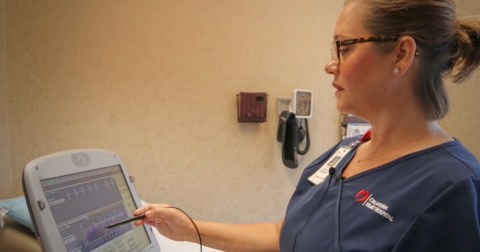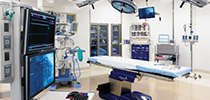Pacemaker and ICD Follow Up

Regular follow-up appointments are important for patients with pacemakers and defibrillators. When a patient arrives at Oklahoma Heart Hospital or one if its satellite pacemaker clinics for a device follow-up appointment, an assistant takes vital signs, talks with the patient about how they have been feeling, and reviews their current medications.
Then the device technician brings in the cart to interrogate the device. A small scanner is placed on the patient’s chest over their implanted device. The technician goes through multiple screens on the connected machine and asks the patient questions as the scanner captures data from the device. The specific questions asked and data captured varies between pacemakers and defibrillators and also varies based on the medical reason for each patient’s device.
The scanner measures the device’s voltage to assess its remaining battery life, checks the leads to ensure they are still in place and functioning properly, and verifies that the shocking lead of a defibrillator is properly placed. These are basic steps that occur at every device follow-up appointment for an implantable device, but the appointment goes beyond simply checking battery life.
The device check also collects heart rhythm data stored in the patient’s device, which will show any changes or abnormalities in the patient’s heart rhythm. In some patients with implantable devices, doctors have diagnosed atrial fibrillation before the patient is even aware of any symptoms. In patients with existing AFib, the device data shows how often they are in AFib, how long an episode of AFib lasts, and when they occur. Some defibrillators measure impedance in the chest, which may show an increase in fluid in the chest in patients with congestive heart failure.
Early diagnosis of heart problems through device data can help reduce the patient’s risk of future cardiac disease or life-threatening effects, such as stroke. The device data may also indicate the need for medication changes or adjustments to how the device paces the heart. Many devices also have an activity monitor that reports how many hours each day the patient is up and moving around. If a patient’s daily activity declines over time, it may signal a need to adjust how the heart is paced or look at other factors that could be impacting the patient’s activity level.
Once the device check is complete, the doctor will discuss the collected data with the patient and determine the best next steps. For many patients, their device check requires no further action until they are due for another device follow-up appointment.
If you have questions about your implanted device and routine follow-up appointments, call the Oklahoma Heart Hospital today for more information.




